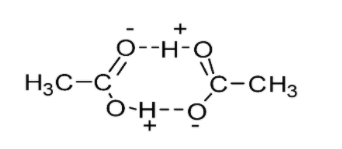
Lower carboxylic acid are soluble in water due to:
A: low molecular weight
B: hydrogen bonding
C: dissociation into ions
D: easy hydrolysis
Answer
495.9k+ views
1 likes
Hint: Carboxylic acids are basically the derivatives of hydrocarbons in which carboxyl group
Complete Step by step answer:
- Carboxylic acids are polar in nature due to the presence of hydroxyl groups. Carboxylic acids consist of the carboxyl group (
- The carboxyl group contains a carbonyl group (
- As the proton in the hydrogen atom nucleus slightly screens the action of the oxygen which pulls the electrons away from hydrogen, it results into a net positive charge over the hydrogen atom. As a result, there is a net negative charge on the oxygen atom which creates an imbalance of charge over the hydroxyl group. Thus, the overall hydroxyl group is considered to be polar as (similar to magnet) it possesses two opposite charges on each end.
- The net positive hydrogen atom can attract the negative electron clouds readily from the oxygen atom in a carbonyl group placed adjacent to it. Unlike Van der Waals’ forces, hydrogen bond involves a permanent imbalance of charges and hence, results in permanent dipole attractions.
- The diagram below demonstrates hydrogen bonding in carboxylic acid (ethanoic acid) molecules. Each ethanoic acid molecule is capable of forming double hydrogen bonded dimers.

Hydrogen bonds are developed between the individual molecules of acid and the water molecules when carboxylic acid is added to water. These interactions make the carboxylic acids soluble in water. Lower carboxylic acids (up to four carbon atoms) are readily soluble in water due to hydrogen bonding.
Hence, the correct answer is Option B.
Note: Higher carboxylic acids are not readily soluble in water owing to increasing hydrophobicity of the alkyl chain. These longer chain acids would rather be soluble in less polar solvents like ethers or alcohols.
Complete Step by step answer:
- Carboxylic acids are polar in nature due to the presence of hydroxyl groups. Carboxylic acids consist of the carboxyl group (
- The carboxyl group contains a carbonyl group (
- As the proton in the hydrogen atom nucleus slightly screens the action of the oxygen which pulls the electrons away from hydrogen, it results into a net positive charge over the hydrogen atom. As a result, there is a net negative charge on the oxygen atom which creates an imbalance of charge over the hydroxyl group. Thus, the overall hydroxyl group is considered to be polar as (similar to magnet) it possesses two opposite charges on each end.
- The net positive hydrogen atom can attract the negative electron clouds readily from the oxygen atom in a carbonyl group placed adjacent to it. Unlike Van der Waals’ forces, hydrogen bond involves a permanent imbalance of charges and hence, results in permanent dipole attractions.
- The diagram below demonstrates hydrogen bonding in carboxylic acid (ethanoic acid) molecules. Each ethanoic acid molecule is capable of forming double hydrogen bonded dimers.

Hydrogen bonds are developed between the individual molecules of acid and the water molecules when carboxylic acid is added to water. These interactions make the carboxylic acids soluble in water. Lower carboxylic acids (up to four carbon atoms) are readily soluble in water due to hydrogen bonding.
Hence, the correct answer is Option B.
Note: Higher carboxylic acids are not readily soluble in water owing to increasing hydrophobicity of the alkyl chain. These longer chain acids would rather be soluble in less polar solvents like ethers or alcohols.
Recently Updated Pages
Master Class 12 English: Engaging Questions & Answers for Success

Master Class 12 Social Science: Engaging Questions & Answers for Success

Master Class 12 Chemistry: Engaging Questions & Answers for Success

Master Class 12 Biology: Engaging Questions & Answers for Success

Master Class 12 Physics: Engaging Questions & Answers for Success

Master Class 12 Business Studies: Engaging Questions & Answers for Success

Trending doubts
When was the first election held in India a 194748 class 12 sst CBSE

What are the major means of transport Explain each class 12 social science CBSE

Savarkar was released from jail in the year A1889 B1905 class 12 social science CBSE

State Snells first and second law of refraction class 12 physics CBSE

How do you convert from joules to electron volts class 12 physics CBSE

What is the importance of evolution class 12 biology CBSE




